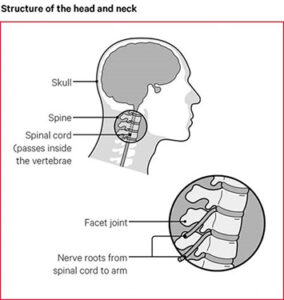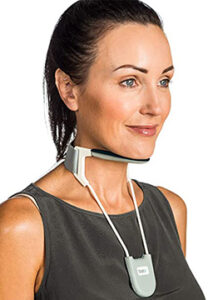
By Dr. Virginia Nsitem
Neck pain can be very disabling and affect all aspects of your life. One of my patients experienced such severe neck pain that he made a visit to the emergency department of the hospital before coming to my office. He was advised at the hospital that he had some muscle spasms and was given some pain medication. When he came to my office, he was not sure what his diagnosis meant, but reported that he was unable to sleep, work, or do most of his usual daily activities. This article will discuss some common causes of neck pain.

The Cervical Spine
The cervical spine (neck) is made up of 7 vertebrae (spinal bones) that join together to provide mobility and flexibility to the neck such as bending the head forward, backward, bending side to side, and turning in both directions. The bones are separated by discs that act as shock absorbers. The spinal cord travels down the centre of the spine and carries information back and forth from the brain to the body. The nerves in the neck travel to our head, neck, shoulders, arms, and hands. There are strong muscles and ligaments that support the front and the back of the neck, and these muscles extend to the head, shoulders, and upper back. Neck pain and dysfunction can be caused by injury or disease to the any of these structures.
Degenerative Joint and Disc Disease
Degenerative joint or disc disease in the neck means that the joints or discs have undergone some wear and tear, or arthritic changes. The joints in the neck develop signs of wear and tear including bone spurs, and the disc material loses water and becomes flatter and more brittle. This degeneration may in the cervical spine may cause bone and joint pain, and pain from the

narrowing of the space for the spinal cord and spinal nerves. The most common symptoms of degenerative changes in the cervical spine include: pain, stiffness, and achy feelings in the neck; muscle spasms in the neck; pain that may refer to the head, shoulders, and arms; numbness and tingling in the arms and hands; neck pain worse with movement and relieved with rest.
Cervical Disc Injuries
A disc herniation is a tear or rupture of the disc that lies between the spinal bones. This type of injury can occur following a traumatic injury, a sudden strain, or following quick and jolting movements of the neck. Studies have shown that discs that have undergone degeneration (arthritic wear and tear), and are more brittle, may be more prone to herniating. Smoking is also a risk factor for disc injuries. Pain from a herniated disc can range from mild to severe, depending on what structures and nerves are involved. Symptoms of a herniated disc include: neck pain, especially with extending and turning the neck; sharp shooting pain in the neck; pain into the shoulder blade, and along the arms into the hands; numbness and tingling in the arms; weakness in the arms and hands.
What treatments are helpful?
The first goal of therapy is to identify what is causing the pain. Visit your chiropractor or family physician for an assessment and diagnosis. This is important to rule out serious causes of your neck pain

before starting a rehabilitation program. Your physician may order x-rays, CT scans, or MRI studies to get a clear picture of the bones, discs, joints, nerves, and soft tissues in the neck. The 5 important parts of rehabilitation program include: Inflammation and pain can be relieved with LASER therapy, ice compresses, acupuncture, massage, and manual therapies; chiropractic treatments, joint mobilization, manual traction, and mechanical traction; active treatments that include specific stretching and strengthening exercises; activities such as walking can be helpful for neck pain and overall wellness; it is important to make sure that your posture is correct when at work, during recreation and sports, and at rest in order to prevent future injuries or worsening of already existing injuries; avoid the risks. Research has shown that poor posture, smoking, and obesity are risk factors for injuries to the spine and discs in the neck. Positive lifestyle changes cannot be overlooked.
Dr. Virginia Nsitem is a chiropractor specializing in laser therapy for muscle, joint, and nerve injuries, and is a Fellow of the Royal College of Chiropractic Sports Sciences in Canada. She may be reached at (905) 275-4993, or by email at totalhealth@bellnet.ca
Stop the Pain … Before it Stops You!


